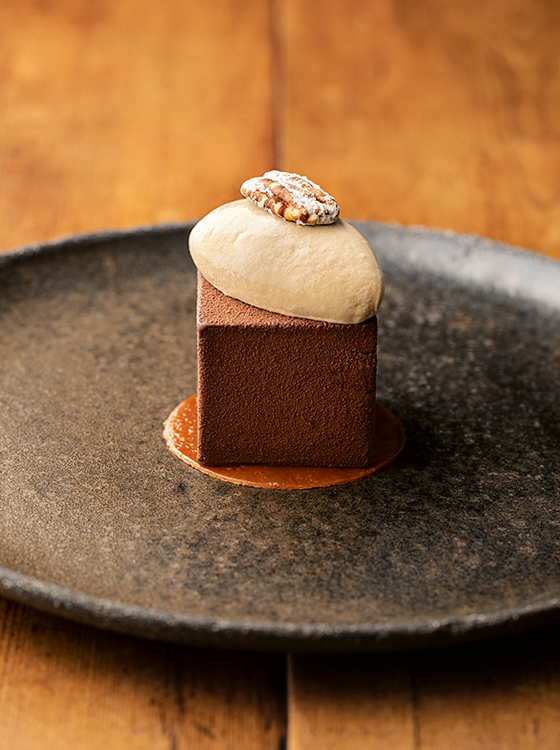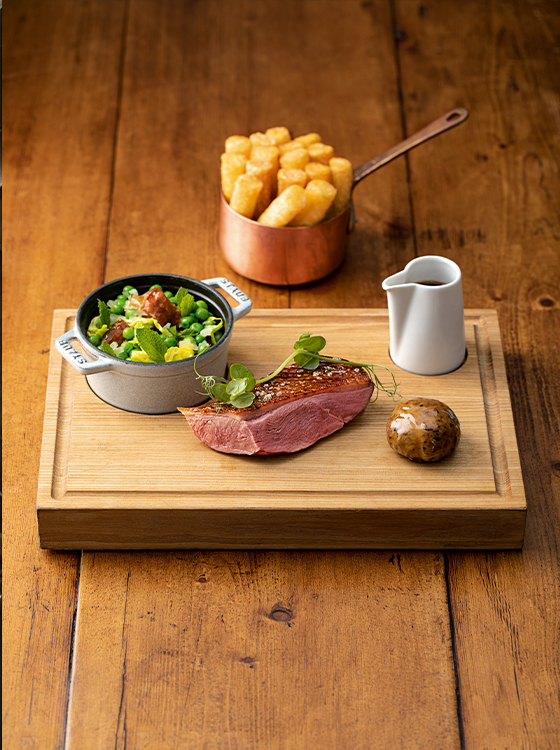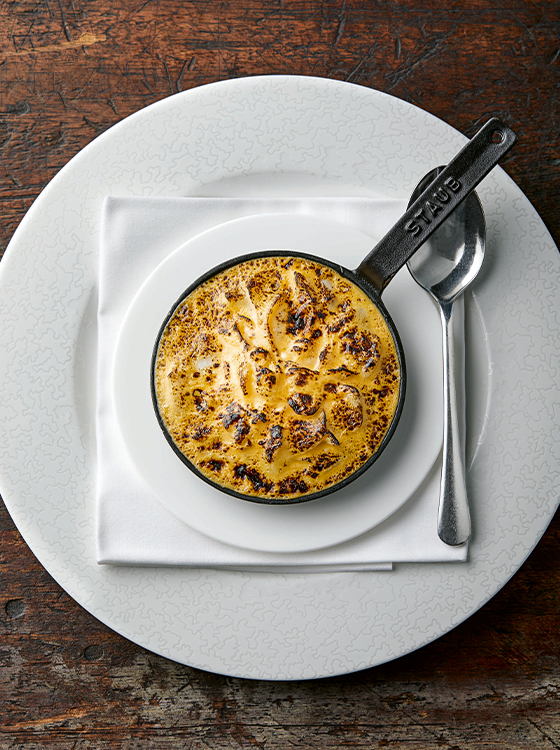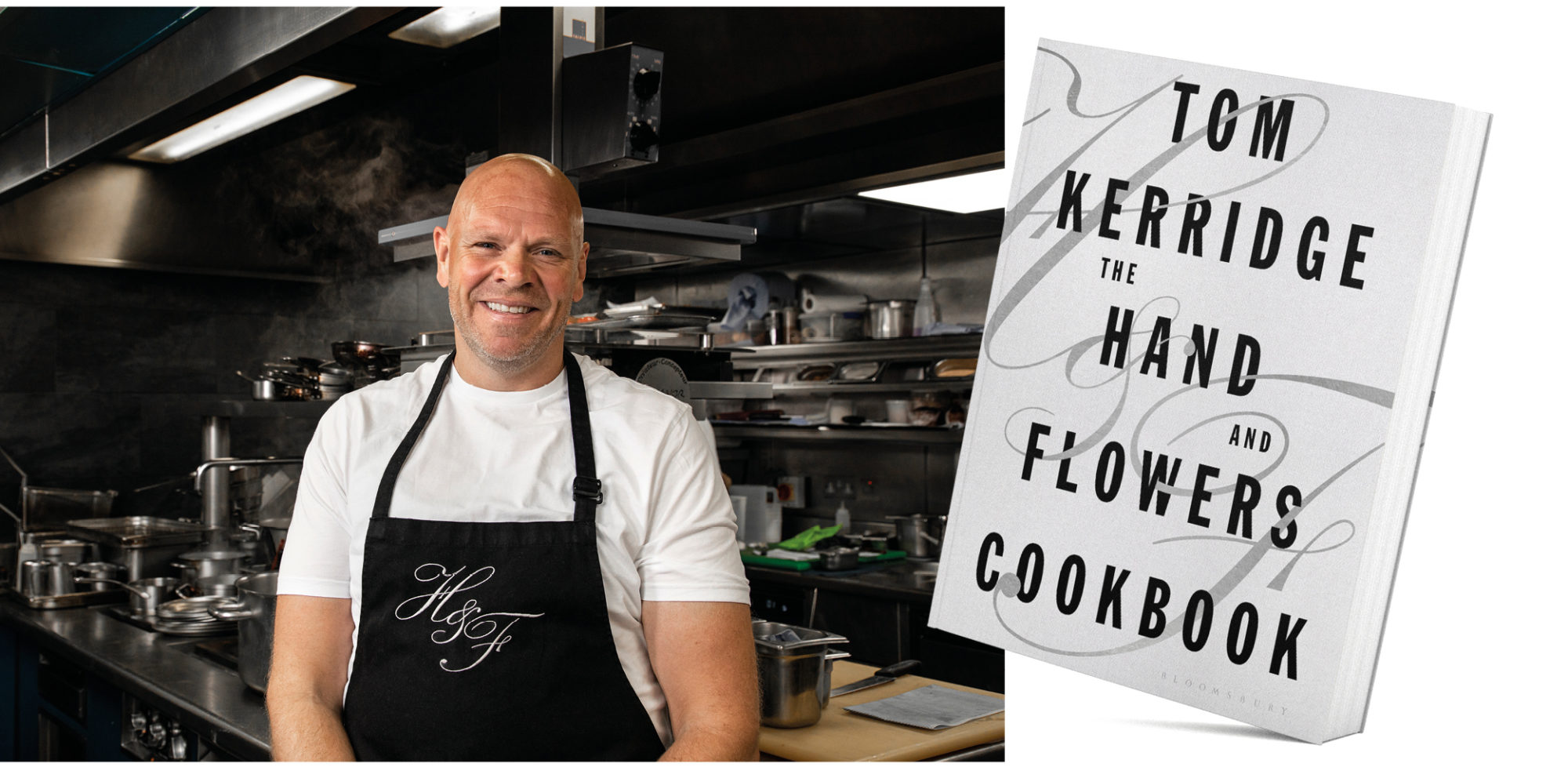Star chef & hospitality champion Tom Kerridge’s new Hand & Flowers cookbook is helping us find reasons to be cheerful. We’ve teamed up to share recipes for you to cook at home.
Chocolate ale sponge with salted caramel

Ingredients:
• 350g plain flour
• ½ tsp baking powder
• 2 tsp bicarbonate of soda
• 400ml dark ale
• 100g cocoa powder
• 220g unsalted butter, softened
• 550g soft dark brown sugar
• 4 large free-range eggs
Salted caramel
• 100g caster sugar
• 40ml water
• 3.5g sea salt
PREP: 10 minutes
COOKING: 20 minutes
SERVES: 12
The Hand & Flowers is a pub. Pubs serve ale. We always needed an ale cake! So that’s the idea behind this particular recipe, which grew out of my first book and TV series, Proper Pub Food, where I taught people how to cook the simpler pub classics at home.
Method:
Preheat the oven to 200°C/Fan 180°C/Gas 6. Line a 33 x 26cm deep baking tin with baking parchment.
Sift the flour, baking powder and bicarbonate of soda together; set aside. In a small bowl, slowly mix the dark ale into the cocoa powder to form a paste.
In a large bowl, cream together the butter and brown sugar until smoothly blended, then beat in the eggs, one at a time. Fold in the cocoa paste and flour mixture alternately, a little at a time.
Spread the mixture in the prepared baking tin and bake for 20 minutes, or until a skewer inserted into the centre comes out clean. Remove the sponge from the tin and place on a wire rack to cool.
Once cooled, cut the chocolate sponge into 2cm cubes and put
to one side.
Salted caramel:
Melt the sugar in a heavy-based saucepan over a low heat, then bring to the boil and continue to cook the sugar syrup until it forms a golden caramel. Add the chopped sablé paste and cook, stirring, for a minute.
Pour the sablé caramel onto a silicone mat and leave to cool slightly.
When it is cool enough, roll out to a thin sheet. While still warm, press a 4cm cutter into the sheet make sablé discs. Leave until cooled and set then lift the sablé tuiles off the mat.
Slow-cooked duck with duck gravy
Ingredients:
• 2 large Aylesbury ducks, about 2kg each
• 3 tsp ground mace
For the duck gravy:
• 500g duck bones and wings, chopped A little vegetable oil for cooking
• 4 carrots, peeled and chopped into 3cm pieces
• 4 celery sticks, cut into 3cm pieces 1 onion, peeled and diced into 3cm pieces
• 1 garlic bulb, cut across in half, through the equator
• 150g runny honey
• 4 cloves
• 2 litres chicken stock
• 50ml soy sauce
• About 500g unsalted butter
• Lemon juice, to taste (optional)
• Sea salt and freshly ground pepper

PREP: 20 minutes
COOKING: 90 minutes
SERVES: 4
Some dishes end up defining you, chef and restaurant. This is one of them. I cooked it at the Great British Menu banquet for Prince Charles and the Duchess of Cornwall in 2010. That raised our profile into the stratosphere: everybody suddenly wanted to book a table at The Hand & Flowers and order duck and chips!
Method:
Remove the legs and wings from the ducks and take out the wishbone (reserve for the faggots, gravy etc., see right and overleaf). Remove the excess fat and skin, placing it all in a frying pan. Now carefully cut away the backbone; you should be left with the crown.
Place the pan of fat and skin over a low heat to render the fat out. Set aside for later use.
Score the skin on the duck crowns and rub in the mace. Heat a heavy-based frying pan over a medium-high heat. Add the duck crowns and sear on all sides for 5–10 minutes to render the fat and give the skin a good golden colour. Remove the duck crowns from the pan and allow to cool.
Put each duck crown into a large vacuum-pack bag and vacuum-seal on full pressure. Immerse in a water-bath at 62°C and cook for
1½ hours.
Lift out the vacuum-pack bags and remove the ducks. Carefully cut the breasts from the crowns. Cover and refrigerate until ready to cook.
Duck gravy:
Preheat the oven to 205°C/Fan 185°C/Gas 6–7. Put the chopped duck bones and wings into a roasting tray and roast in the oven for about 25–30 minutes until golden brown and caramelised.
Heat a little oil in a large heavy-based saucepan over a medium-high heat. Add the chopped carrots and colour until darkly caramelised. Add the celery, onion and garlic and similarly colour until well browned.
Remove the duck bones and wings from the roasting tray and add them to the saucepan. Drain off the excess fat from the roasting tray, then add the honey and cloves to the tray. Place over a medium heat and take the honey to a dark golden caramel.
Add a splash of the chicken stock and the soy sauce to deglaze the tray, stirring to scrape up the sediment. Add the liquor to the duck bones and vegetables. Pour in the rest of the chicken stock and reduce down by half, to 1 litre.
Pass the liquor through a muslin-lined sieve into a clean pan and skim off any excess fat from the surface. Add 250g butter to every 500ml duck liquor and reduce down until it has emulsified into the sauce.
Season with salt and pepper and add a little lemon juice if required. Set aside for serving.
Smoked haddock omelette

Ingredients:
• 12 medium free-range eggs
• 4 tbsp unsalted butter
• 100g aged Parmesan, finely grated
• Sea salt & ground pepper
Poached smoked haddock:
• 1 side of smoked haddock, 600g, skin and pin bones removed
• 600ml whole milk
Smoked fish béchamel:
• 250ml smoked haddock poaching liquor (see left)
• 15g unsalted butter
• 15g plain flour
• Sea salt & ground pepper
Omelette glaze:
• 4 tbsp warm smoked haddock béchamel (see left)
• 4 tbsp hollandaise sauce
• 4 medium egg yolks
• Sea salt & ground pepper
PREP: 10 minutes
COOKING: 20 minutes
SERVES: 4
A delicate, beautiful omelette is one of those pure dishes that makes you realise great food does not have to be about hundreds of ingredients on a plate. It’s about allowing a simple product to sing.
Method:
Check the smoked haddock for any tiny pin bones. Bring the milk to the boil in a wide-based saucepan. Carefully lay the smoked haddock in the pan, ensuring it is covered by the milk. Place a lid on the pan, turn off the heat and leave the fish to poach in the residual heat for about 10 minutes.
Once the haddock is cooked, remove it from the milk and gently flake the fish into a tray lined with greaseproof paper. Cover the tray with cling film and place in the fridge until ready to serve.
Pass the milk through a fine chinois into a clean saucepan and keep to one side.
Smoked fish béchamel:
Bring the smoked haddock poaching liquor to a gentle simmer.
In a separate pan over a medium-low heat, melt the butter. Stir in the flour to make a roux and cook, stirring, for 2 minutes. Gradually ladle in the warm poaching liquor, stirring as you do so to keep the sauce smooth. Cook gently over a very low heat for 20 minutes.
Pass the sauce through a fine chinois and cover the surface with a piece of baking parchment or cling film to prevent a skin forming. Set aside until needed. (You won’t need all of the fish béchamel but you can freeze the rest.)
Omelette glaz:
Gently warm the béchamel in a saucepan then pour into a bowl and whisk in the hollandaise and egg yolks. Season with salt and pepper to taste and pass through a chinois into a warm jug or bowl. Keep warm to stop the glaze from splitting.
To assemble & cook the omelette:
Crack the eggs into a jug blender and blend briefly to combine. Pass through a chinois into a measuring jug. Place 4 individual omelette pans (we use Staub) over a low heat.
Take the smoked haddock from the fridge, remove the cling film and lay on a grill tray. Warm under the salamander or grill.
To each omelette pan, add 1 tbsp butter and heat until melted and foaming. Pour the blended egg into the pans, dividing it equally. Using a spatula, gently move the egg around in the pans until they start to firm up. Remove from the heat; you want the eggs to be slightly loose, as they will continue to cook off the heat.
Season the omelettes with salt and pepper and sprinkle the grated Parmesan over their surfaces. Divide the flaked smoked haddock between the omelettes, then spoon on the glaze to cover the fish and extend to the edge of the pans. If the glaze spills over the side of the pan, wipe it away, as this will burn on the side when blowtorching.
To finish, wave a cook’s blowtorch over the surface of the omelettes to caramelise the glaze. Allow the glaze to become quite dark, as
the bitterness will balance out the richness of all the other ingredients.








